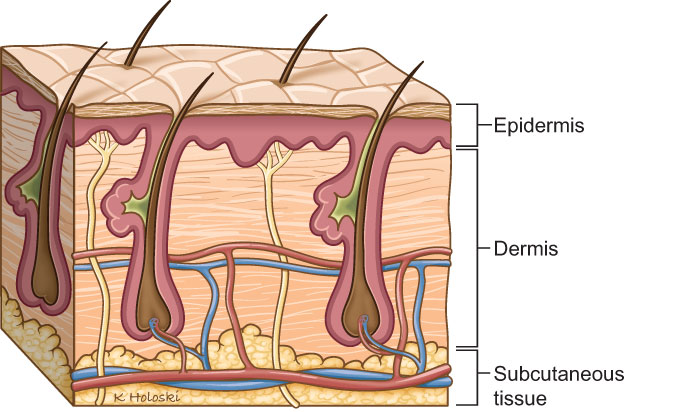As the weather turns warmer in the United States, many of us will be enjoying backyard bonfires and campfire sing-alongs with friends and family. Yet those beautiful and comforting flames are just one potential source for burning not only you, but also your fur babies. Burns, are thankfully relatively uncommon, but understandably can often painful and even deadly. This week I share some pertinent information about burns in dogs and cats. Happy reading!
Burns: How do they occur?
Burns can be causes by heat sources, certain chemicals, and even radiation. In companion animals, thermal injury is the most common cause of burns. Common sources of heat-related burns are:
- Open flames (campfires, bonfires)
- Sun
- Electrical currents
- Hot/boiling liquids (e.g. water, cooking oil)
- Heat lamps
- Electrical heating pads
Burns: How are they characterized?
Skin has three major layers:
- Epidermis – outer layer of skin
- Dermis – layer of tissue below the epidermis that contains blood capillaries, nerve endings, hair follicles, and other structures
- Hypodermis – also called subcutaneous tissue, this layer is the deepest layer of skin

Burns in animals are categorized by how deeply the injury penetrates the skin. Possible types are:
- Superficial (first degree) – these burns only involve the epidermis. The skin appears red and non-blistered; the affected region is painful but typically heals in five days without scarring.

- Superficial partial thickness (second degree) – these burns involve the epidermis and one half of the dermis. The affected region is painful, has blisters, turns white when pressure is applied (called blanching), and takes 2-3 weeks to heal.
- Deep partial thickness (second degree) – these burns involve the epidermis and all of the dermis. The affected region does not blanch, can be dry or blistered, and slowly heals with scarring and loss of function

- Full thickness (third degree) – these burns involve the dermis, epidermis, and hypodermis. Affected skin is typically dry and leather-like in appearance and feel. The skin may be white or charred, and contracts as it heals.

- Fourth degree – these burns involve all layers of the skin and also extend into muscle and bone.
Burns: How are they treated?
The ideal treatment of a burn is the prevention of the burn in the first place. Alas accidents do happen. Therefore, the best thing for dog or cat burn victims is for their families to seek veterinary medical attention as soon as possible. Pet parents should note burn patients are often experiencing tremendous pain and may (try to) bite. Family members should use caution to avoid being bitten, potentially by using a muzzle. Prior to arrival at a veterinary hospital (and/or during transport to the hospital), families can provide some basic first aid, including:
- Apply a cool clean cloth compress to skin injured by a heat source
- Don’t apply ice to the affected area
- Don’t submit a pet in cold water
- Don’t rupture any blisters
- Don’t apply any creams or ointments
- Flush eyes with clean water or sterile saline if a chemical has gotten into a pet’s eyes
Pet parents should wear gloves to prevent personal injury when a chemical burn has happened. Be sure to turn off electricity and unplug the inciting equipment before touching a patient or surrounding cords when an electrical burn has occurred.
The degree of medical and surgical intervention needed for a burn victim depends on the type of burn and the amount of body surface affected. Interestingly the full extent of a burn is typically not known for a couple of days after the accident. A veterinarian will perform a complete physical examination to appropriately evaluate an affected pet. Blood and urine samples will be collected to evaluated white and red blood cells, as well as electrolytes (e.g.: sodium, potassium), kidney values, and liver enzymes. Once the full extent of a burn is known, a veterinarian will perform further appropriate burn care. This will likely include:
- Wound management that may include surgery
- Fluid therapy
- Pain management
- Antibiotic therapy to prevent secondary bacterial infections
- Nutritional support
Family veterinarians are often comfortable and adept at managing patients with superficial and partial thickness burns. However, for more severe burn victims, they may recommend referral to a veterinary referral center where affected pets can receive care from board-certified emergency and critical care specialists and board-certified veterinary surgeons.
The take-away message about burns in dogs and cats…
Burn injuries in dogs and cats are thankfully uncommon. However, just as in people, they can be severe and life-threatening. A patient’s prognosis depends on several factors, particularly the extent of the body involved in the burn. The more body surface involved, the worse the prognosis, and patients with more than 30% body involvement generally have a grave prognosis. Partnering with board-certified veterinary specialists in emergency and critical care, as well as surgery, can be instrumental in maximizing the likelihood of a positive outcome.
To find a board-certified veterinary emergency and critical care specialist, please visit the American College of Veterinary Emergency and Critical Care.
To find a board-certified veterinary surgeon, please visit the American College of Veterinary Surgeons.
Wishing you wet-nosed kisses,
cgb





